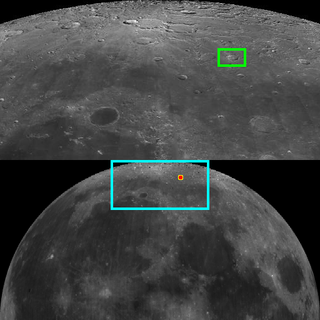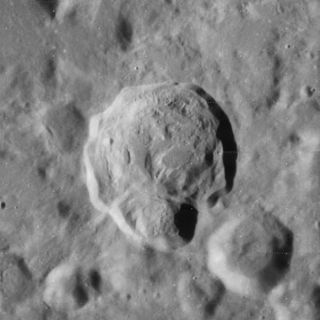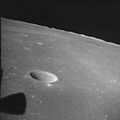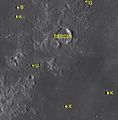
Messier is a relatively young lunar impact crater located on the Mare Fecunditatis. The crater has a discernible oblong shape that is not caused by foreshortening. The longer dimension is oriented in an east–west direction.

Brackett is a small lunar impact crater that lies near the southeast edge of Mare Serenitatis. The crater is named after American physicist Frederick Sumner Brackett. The crater has been covered by lava flow, leaving only a ring-shaped trace in the surrounding lunar mare. This crater is best observed under oblique illumination, as it is otherwise difficult to find. The southern rim is almost contacting a rille system named the Rimae Plinius.

Nicholson is a lunar impact crater located at the western limb. In this position it is subject to libration, which can limit observation. The crater is also viewed at a very oblique angle, so it is seen from the side when observed from the Earth. It is an irregular, somewhat pear-shaped formation that has an uneven rim due to its location amidst rugged ground. The rim is sharp-edged and the inner wall varies in thickness, being narrower along the northern side and wider at the southern end. The interior floor is rough, small and uneven, with no impacts of significance. There is a small central ridge.

Lubbock is a small lunar impact crater on the western edge of Mare Fecunditatis. It was named after British astronomer John Lubbock. It is located to the north of the crater Gutenberg and south of Secchi. Lubbock is circular, with a low rim and flat interior. There is a small break in the eastern wall.

Jansen is a lunar impact crater in the north part of the Mare Tranquillitatis. The diameter is 24 km. It was named after 17th century Dutch optician Zacharias Janssen. It is located to the east-southeast of the crater Plinius. The rim of Jansen is low and narrow, with a notch along the western edge. The interior is relatively level, which may indicate it has been covered by lava. To the south-southwest a small but prominent crater lies on the crater floor, halfway between the center and the rim.

Carrel is a small lunar crater on the Mare Tranquillitatis. It has a somewhat distorted appearance, having a slight protruding bulge in the northwest rim. The interior is somewhat irregular, with ridges and some slumped material. This crater lies across a ridge in the surface of the mare.

Abel is an ancient lunar impact crater that lies near the southeast limb of the Moon's near side. It is located to the south of the crater Barnard, at the northwest edge of the Mare Australe.

Archytas is a lunar impact crater that protrudes into the northern edge of Mare Frigoris. To the northwest is the comparably sized crater Timaeus, and the smaller Protagoras lies in the opposite direction to the southeast. Further to the southwest, beyond the opposite edge of the mare, is the dark-floored crater Plato.

Atwood is a small earth moon impact crater that is located on the Mare Fecunditatis, to the northwest of the prominent crater Langrenus. It forms a triple-crater formation with Naonobu attached to the north rim and Bilharz near the west rim.

C. Mayer is a lunar impact crater that is located at the northern edge of the Mare Frigoris, due north of the prominent crater Aristoteles. Also to the south, but only a third as distant, is the smaller crater Sheepshanks. Due east of C. Mayer is the flooded crater Kane.

Fabbroni is a small lunar impact crater that lies along the northern edge of the Mare Tranquillitatis, at the eastern edge of the gap where the lunar mare joins Mare Serenitatis to the north. To the southeast is the crater Vitruvius.

Newcomb is a lunar impact crater that is located in the rugged Montes Taurus mountain range, to the east of the Mare Serenitatis. It lies to the northeast of the prominent crater Römer, and north-northwest of Macrobius.

Fourier is a lunar impact crater that is located in the southwestern part of the Moon's near side, just to the southeast of the crater Vieta. To the northeast is the Mare Humorum. The rim of this crater is roughly circular, but appears oval when viewed from the Earth due to foreshortening.

Ibn Firnas is a lunar impact crater on the far side of the Moon. In 1976 it was named after Abbas Ibn Firnas, a polymath from Andalucia who, in the 9th century, devised a chain of rings that could be used to simulate the motions of the planets and stars.

Dziewulski is a lunar impact crater on the far side of the Moon. It lies between the craters Edison to the north and Popov to the south. The outer rim of this crater has been considerably worn by impacts, particularly along the southwest quadrant where the satellite crater Dziewulski Q overlies the rim and the interior floor. The northern rim is also heavily disrupted, and several small crater lie along the southeast rim. The interior floor and surrounding terrain has been resurfaced.

Dreyer is the remnant of a lunar impact crater on the far side of the Moon. It is located along the eastern edge of the Mare Marginis, about midway between the craters Ginzel to the north and Erro to the south-southeast. It was named after Danish-Irish astronomer John L. E. Dreyer.

Firsov is a lunar impact crater on the far side of the Moon. It is located to due south of the crater Lobachevskiy, and to the northwest of Abul Wáfa. The circular rim of this crater has a small outward bulge along the southern edge, and smaller bulges along the western side. The inner walls have slumped to form talus piles along the base. The low-albedo interior floor is nearly level and featureless.

Mandel'shtam is the remains of a large crater on the Moon's far side. Nearly attached to the northeast outer rim is the crater Papaleksi. To the south lies the crater Vening Meinesz.

Lobachevskiy is a lunar impact crater that is located on the far side of the Moon, beyond the eastern limb. It was named after Russian mathematician Nikolai Lobachevsky in 1961. This crater lies to the southeast of the larger crater Fleming. Less than a crater diameter to the east-northeast lies Guyot.

Parkhurst is a heavily degraded lunar impact crater to the northeast of the Mare Australe on the far side of the Moon. To the north-northeast of Parkhurst is the crater Scaliger and to the southwest lies the dark-floored Gernsback. The small lunar mare named Lacus Solitudinis lies due north of Parkhurst.
























